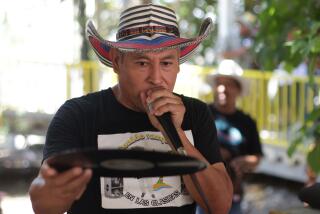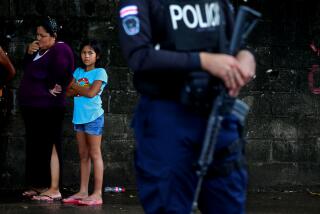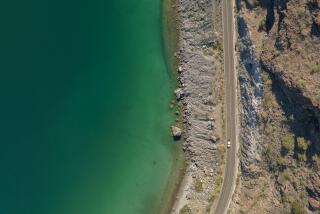Discovering the Incredible Lost City in the Mountains of Colombia
- Share via
Just 12 years ago, while searching for ancient relics, treasure hunter Julio Cesar Sepulveda discovered the remains of a 1,000-year-old city on a mountain face almost 4,000 feet above sea level in northeastern Colombia.
The Lost City, as Sepulveda’s wondrous find was named, is about 40 times the size of Peru’s Machu Picchu. It was built by an Indian civilization known as the Tairona. Their cities were masterpieces of urban planning.
The stonework doesn’t match the precision of the Incas’ work, but the Lost City’s design demonstrates an ecological awareness beyond that of the Incas.
For hundreds of years before the arrival of the Spanish, the Tairona built great stone cities as well as smaller settlements. Archeologists estimate that there are more than 250 unexcavated sites in the Sierra Nevada de Santa Marta mountain range.
Dazzled by Gold
When Spanish explorers came to northern Colombia in the early 16th Century, they were dazzled by the gold worn and used by Indians. The Tairona especially were renowned for their sophisticated gold working, using some techniques not known in Europe at that time.
After almost 100 years of resistance to the Spaniards, the Tairona were overcome in 1600, and their highly advanced civilization destroyed.
Our guide at the Lost City was Camilo Avila, an enthusiastic young architect from Bogota. He was there for two months studying the accomplishments of the Tairona city planners of long ago.
Avila led us to a steep, granite stairway and we began our careful descent into the shadowy rain forest. The temperature was comfortable--probably in the low 70s--but the humidity was high. The steps were damp and covered with moss, making them treacherously slippery.
Series of Settlements
We had a lot of ground to cover (only about two square miles had been excavated), and only a few hours in which to do it. Instead of a centralized metropolis, the Lost City is a series of about 300 specialized settlements along mountain ridges, each housing about 3,000 people. Some archeologists believe as many as 1 million people may once have lived there.
Avila showed us the five-foot-wide stone road encircling the Lost City, comparing it to a “New York beltway.” We walked hurriedly along smaller routes that crisscrossed past terraces, commercial squares, ceremonial centers and the circular stone foundations of houses once covered in bamboo, wood and palm leaves.
Many mysteries still puzzle researchers. For example, all those paths that end abruptly at the edge of a precipice. Were offerings once made from those spots, or did bridges span the wide chasms?
Mysterious Squiggles
Perhaps most intriguing is the six-foot-high boulder known as the Map Stone. It stands upright at the edge of a small clearing, one face full of undeciphered squiggly lines and curves. It could be a map, or maybe someone was merely sharpening a tool.
Because of the frequent and drenching rainfall, proper water drainage was of major concern to the ancient builders. Retaining walls and carefully angled steps served as guides for water channeling. They still do, which is why the Lost City remains free of erosion damage.
At one point Avila suddenly stopped talking and started hustling us back to our starting point. Three hours had rushed by unnoticed. The fog was rolling in, as it does every day about noon. Our helicopter had to take off from the small, grassy heliport, which was once was an Indian terrace, before the cloud covering became too low, or we would be grounded until the next morning.
Fly or Hike
Most visitors arrive by helicopter from Santa Marta, a Caribbean port and resort city, because there are no roads. During the 45-minute flight, the semi-arid coastal landscape gives way to lush jungle as you skim over deep canyons and past peaks buried in fog.
The more adventurous, and those who wish to spend more time at the Lost City, can do a three- to four-day hike in from the coast. Simple huts along the way provide free overnight shelter. Most tourist hotels around Santa Marta know guides available to accompany trekkers.
For more information on visiting the Lost City or for general information on Colombia, contact the Columbian Government Tourist Office, 140 E. 57th St., New York 10022; phone (212) 688-0151.
For reservations and information on arranging an excursion to the Lost City, contact AVIATUR, 1633 N. Bayshore Drive, Miami, Fla. 33132; phone (305) 358-4554. The cost of $135 per person includes the flight from Santa Marta Airport to the Lost City, plus a two-hour guided visit of the city. No food is included and there are no concession stands at the site.
Tourist Accommodations
Just east of Santa Marta is the hotel and recreation center of El Rodadero, facing Gaira Bay. The excellent tourist facilities include hotels, outdoor cafes, casinos, discotheques and white-sand beaches.
The Hotel Santamar is a luxury resort on a private beach, about five miles from El Rodadero. It has 130 rooms, all with color TV, air conditioning and refrigerators. Also, two restaurants, a disco, 24-hour room service and three swimming pools.
Prices in the high season (Dec. 15 to April 15 and June 15 to Aug. 31) are $44 double, $47 double bungalow and $100 for a suite. The price of a double drops to $37 during the low season.
The Hotel La Sierra sits next to the beach in the heart of El Rodadero. It has 74 rooms with TV, air conditioning and mini-bars, plus an outdoor cafe overlooking the beach that serves excellent fish and seafood (full meal about $5).
Room prices are $40 double and $60 suite in high season, $30 double low season. The hotel is part of German Morales and Sons Hotel Organization based in Bogota. For reservations contact the Bogota headquarters at Calle 75 No. 6-62.
More to Read
Sign up for Essential California
The most important California stories and recommendations in your inbox every morning.
You may occasionally receive promotional content from the Los Angeles Times.










